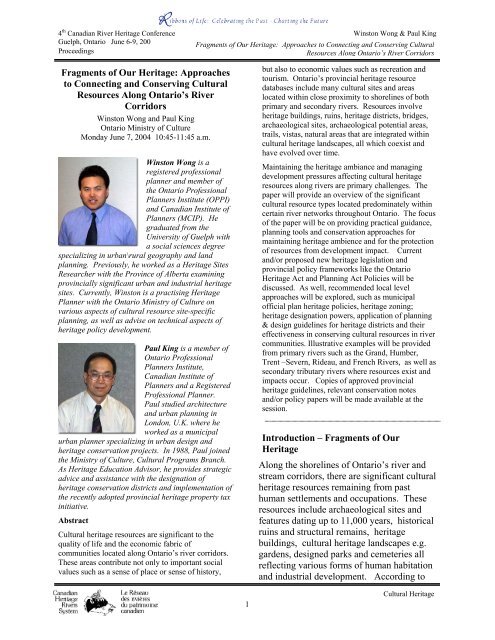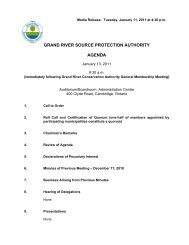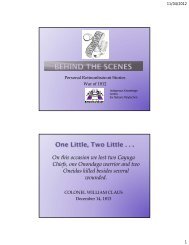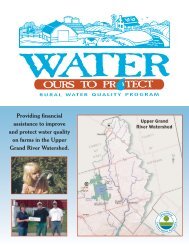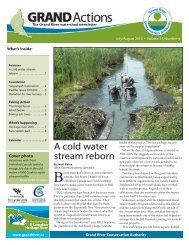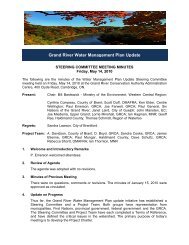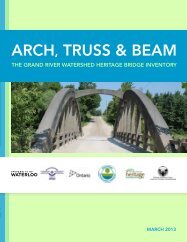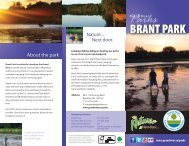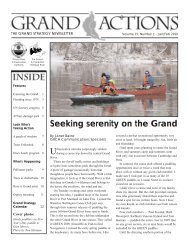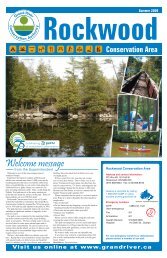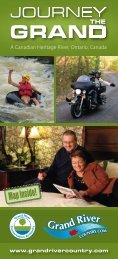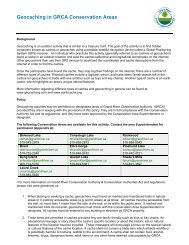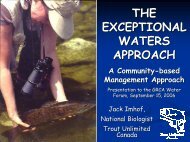Fragments of Our Heritage - Grand River Conservation Authority
Fragments of Our Heritage - Grand River Conservation Authority
Fragments of Our Heritage - Grand River Conservation Authority
You also want an ePaper? Increase the reach of your titles
YUMPU automatically turns print PDFs into web optimized ePapers that Google loves.
4 th Canadian <strong>River</strong> <strong>Heritage</strong> Conference Winston Wong & Paul King<br />
Guelph, Ontario June 6-9, 200<br />
<strong>Fragments</strong> <strong>of</strong> <strong>Our</strong> <strong>Heritage</strong>: Approaches to Connecting and Conserving Cultural<br />
Proceedings<br />
Resources Along Ontario’s <strong>River</strong> Corridors<br />
<strong>Fragments</strong> <strong>of</strong> <strong>Our</strong> <strong>Heritage</strong>: Approaches<br />
to Connecting and Conserving Cultural<br />
Resources Along Ontario’s <strong>River</strong><br />
Corridors<br />
Winston Wong and Paul King<br />
Ontario Ministry <strong>of</strong> Culture<br />
Monday June 7, 2004 10:45-11:45 a.m.<br />
Winston Wong is a<br />
registered pr<strong>of</strong>essional<br />
planner and member <strong>of</strong><br />
the Ontario Pr<strong>of</strong>essional<br />
Planners Institute (OPPI)<br />
and Canadian Institute <strong>of</strong><br />
Planners (MCIP). He<br />
graduated from the<br />
University <strong>of</strong> Guelph with<br />
a social sciences degree<br />
specializing in urban\rural geography and land<br />
planning. Previously, he worked as a <strong>Heritage</strong> Sites<br />
Researcher with the Province <strong>of</strong> Alberta examining<br />
provincially significant urban and industrial heritage<br />
sites. Currently, Winston is a practising <strong>Heritage</strong><br />
Planner with the Ontario Ministry <strong>of</strong> Culture on<br />
various aspects <strong>of</strong> cultural resource site-specific<br />
planning, as well as advise on technical aspects <strong>of</strong><br />
heritage policy development.<br />
Paul King is a member <strong>of</strong><br />
Ontario Pr<strong>of</strong>essional<br />
Planners Institute,<br />
Canadian Institute <strong>of</strong><br />
Planners and a Registered<br />
Pr<strong>of</strong>essional Planner.<br />
Paul studied architecture<br />
and urban planning in<br />
London, U.K. where he<br />
worked as a municipal<br />
urban planner specializing in urban design and<br />
heritage conservation projects. In 1988, Paul joined<br />
the Ministry <strong>of</strong> Culture, Cultural Programs Branch.<br />
As <strong>Heritage</strong> Education Advisor, he provides strategic<br />
advice and assistance with the designation <strong>of</strong><br />
heritage conservation districts and implementation <strong>of</strong><br />
the recently adopted provincial heritage property tax<br />
initiative.<br />
Abstract<br />
Cultural heritage resources are significant to the<br />
quality <strong>of</strong> life and the economic fabric <strong>of</strong><br />
communities located along Ontario’s river corridors.<br />
These areas contribute not only to important social<br />
values such as a sense <strong>of</strong> place or sense <strong>of</strong> history,<br />
but also to economic values such as recreation and<br />
tourism. Ontario’s provincial heritage resource<br />
databases include many cultural sites and areas<br />
located within close proximity to shorelines <strong>of</strong> both<br />
primary and secondary rivers. Resources involve<br />
heritage buildings, ruins, heritage districts, bridges,<br />
archaeological sites, archaeological potential areas,<br />
trails, vistas, natural areas that are integrated within<br />
cultural heritage landscapes, all which coexist and<br />
have evolved over time.<br />
Maintaining the heritage ambiance and managing<br />
development pressures affecting cultural heritage<br />
resources along rivers are primary challenges. The<br />
paper will provide an overview <strong>of</strong> the significant<br />
cultural resource types located predominately within<br />
certain river networks throughout Ontario. The focus<br />
<strong>of</strong> the paper will be on providing practical guidance,<br />
planning tools and conservation approaches for<br />
maintaining heritage ambience and for the protection<br />
<strong>of</strong> resources from development impact. Current<br />
and/or proposed new heritage legislation and<br />
provincial policy frameworks like the Ontario<br />
<strong>Heritage</strong> Act and Planning Act Policies will be<br />
discussed. As well, recommended local level<br />
approaches will be explored, such as municipal<br />
<strong>of</strong>ficial plan heritage policies, heritage zoning;<br />
heritage designation powers, application <strong>of</strong> planning<br />
& design guidelines for heritage districts and their<br />
effectiveness in conserving cultural resources in river<br />
communities. Illustrative examples will be provided<br />
from primary rivers such as the <strong>Grand</strong>, Humber,<br />
Trent –Severn, Rideau, and French <strong>River</strong>s, as well as<br />
secondary tributary rivers where resources exist and<br />
impacts occur. Copies <strong>of</strong> approved provincial<br />
heritage guidelines, relevant conservation notes<br />
and/or policy papers will be made available at the<br />
session.<br />
Introduction – <strong>Fragments</strong> <strong>of</strong> <strong>Our</strong><br />
<strong>Heritage</strong><br />
Along the shorelines <strong>of</strong> Ontario’s river and<br />
stream corridors, there are significant cultural<br />
heritage resources remaining from past<br />
human settlements and occupations. These<br />
resources include archaeological sites and<br />
features dating up to 11,000 years, historical<br />
ruins and structural remains, heritage<br />
buildings, cultural heritage landscapes e.g.<br />
gardens, designed parks and cemeteries all<br />
reflecting various forms <strong>of</strong> human habitation<br />
and industrial development. According to<br />
1<br />
Cultural <strong>Heritage</strong>
4 th Canadian <strong>River</strong> <strong>Heritage</strong> Conference Winston Wong & Paul King<br />
Guelph, Ontario June 6-9, 200<br />
<strong>Fragments</strong> <strong>of</strong> <strong>Our</strong> <strong>Heritage</strong>: Approaches to Connecting and Conserving Cultural<br />
Proceedings<br />
Resources Along Ontario’s <strong>River</strong> Corridors<br />
current Ontario Provincial databases, there<br />
are approximately 17,000 registered<br />
archaeological sites, approximately 5,500<br />
individual properties designated under Part<br />
IV, and 70 <strong>Heritage</strong> <strong>Conservation</strong> Districts<br />
designated under Part V <strong>of</strong> the Ontario<br />
<strong>Heritage</strong> Act (Ministry <strong>of</strong> Culture Databases<br />
2004). There are also numerous other<br />
culturally significant heritage areas and sites<br />
recognized locally or regionally which are<br />
not part <strong>of</strong> the provincial database, as well as<br />
many properties where there is the likelihood<br />
<strong>of</strong> archaeological remains being identified or<br />
areas having archaeological potential.<br />
There are important challenges to the<br />
conservation and planning <strong>of</strong> cultural<br />
heritage resources located along Ontario’s<br />
network <strong>of</strong> rivers. Historical settlement<br />
patterns along river corridors have evolved<br />
over time, <strong>of</strong>ten overlapping, intersecting and<br />
leading to a fractured geography. With the<br />
passing <strong>of</strong> time, there is continuous<br />
fragmentation <strong>of</strong> heritage sites, due to natural<br />
erosion or intrusion <strong>of</strong> contemporary<br />
landuses and land developments.<br />
Interpretation <strong>of</strong> the relationships and<br />
connections among heritage sites and features<br />
also represent several challenges.<br />
These linkages with archaeological site,<br />
individual buildings or structures, and<br />
landscapes are at times dis-continuous and<br />
dis-connected, especially along the extensive<br />
networks <strong>of</strong> river corridors. It is therefore<br />
important to understand some <strong>of</strong> the<br />
relationships among archaeological remains<br />
and individual heritage buildings or<br />
structures, and how these may collectively<br />
form a significant cultural heritage river<br />
landscape worthy <strong>of</strong> careful conservation<br />
(Figure 1).<br />
Figure 1: Understanding the Relationships: Significant Cultural <strong>Heritage</strong> Resources Along <strong>River</strong> Corridors<br />
Source: MCL<br />
Archaeological Sites and Resources:<br />
The remains and artifacts <strong>of</strong> any building, structure, activity, place, cultural feature which because <strong>of</strong> the<br />
passage <strong>of</strong> time are on or below the surface <strong>of</strong> the land or water. These can be both prehistoric and<br />
historic.<br />
Individual Buildings, Built <strong>Heritage</strong> Properties, Features, Visible Ruins:<br />
There may be strong relationships with archaeological remains being located on properties with significant<br />
buildings, monuments, installations, or remains associated with architectural, cultural, social, political,<br />
economic, or military history, and identified as being important to a community.<br />
Cultural <strong>Heritage</strong> Landscapes, <strong>Heritage</strong> <strong>River</strong> Corridors, Connections <strong>of</strong><br />
Human Settlement Patterns<br />
Both archaeological remains and individual heritage properties or structures can collectively form a<br />
significant cultural heritage landscape, especially along linear corridors like rivers. These are defined<br />
geographical areas <strong>of</strong> heritage significance which has been modified by human activities and is valued<br />
by a community. It involves a grouping(s) <strong>of</strong> individual heritage features such as structures, spaces,<br />
archaeological sites, and natural elements, which together form a significant type <strong>of</strong> heritage form,<br />
distinctive from that <strong>of</strong> its constituent elements or parts<br />
MCL 2004<br />
2<br />
Cultural <strong>Heritage</strong>
4 th Canadian <strong>River</strong> <strong>Heritage</strong> Conference Winston Wong & Paul King<br />
Guelph, Ontario June 6-9, 200<br />
<strong>Fragments</strong> <strong>of</strong> <strong>Our</strong> <strong>Heritage</strong>: Approaches to Connecting and Conserving Cultural<br />
Proceedings<br />
Resources Along Ontario’s <strong>River</strong> Corridors<br />
Such heritage river landscapes can be<br />
geographically and spatially defined as<br />
physical entities on the ground, within the<br />
legislative frameworks, policies and plans<br />
developed for landscape resource protection.<br />
Realistic yet practical methodologies,<br />
techniques and management plans can be<br />
created to identify cultural heritage landscape<br />
elements for conservation purposes; further<br />
interpreted within an urban planning context.<br />
The three types <strong>of</strong> cultural resources are all<br />
reflected in various provincial databases. Such<br />
databases include comprehensive and updated<br />
information on archaeological site locations,<br />
archaeological site and artifact descriptions,<br />
searchable databases which include built<br />
heritage properties designated under Part IV<br />
and Part V <strong>of</strong> the Ontario <strong>Heritage</strong> Act (A<br />
database is available on the Ministry <strong>of</strong> Culture<br />
internet web page-Figure 2). The databases do<br />
not however include comprehensive<br />
archaeological potential mapping coverage for<br />
Ontario. Rather, provincial technical advice is<br />
provided to various regions and municipalities<br />
for development <strong>of</strong> archaeological master<br />
plans such as a plan for the City <strong>of</strong> Ottawa<br />
(Figure 3). This archaeological potential<br />
mapping developed covers the entire city<br />
region, and serves as an effective tool for<br />
municipal landuse planners when requiring<br />
appropriate archaeological assessments or<br />
studies.<br />
Figure 2: Ministry <strong>of</strong> Culture Webpage <strong>Heritage</strong> Properties Database<br />
source: MCL 2004<br />
3<br />
Cultural <strong>Heritage</strong>
4 th Canadian <strong>River</strong> <strong>Heritage</strong> Conference Winston Wong & Paul King<br />
Guelph, Ontario June 6-9, 200<br />
<strong>Fragments</strong> <strong>of</strong> <strong>Our</strong> <strong>Heritage</strong>: Approaches to Connecting and Conserving Cultural<br />
Proceedings<br />
Resources Along Ontario’s <strong>River</strong> Corridors<br />
Figure 3: Archaeological potential areas identifed along the Rideau <strong>River</strong> in Ottawa<br />
source: City <strong>of</strong> Ottawa archaeological master plan<br />
Ontario<br />
Ontario<br />
Change Affecting Heritag<br />
New development proposals can embrace<br />
and enhance the site’s heritage attributes as<br />
well as cause irreversible impact if<br />
significant elements are not identified and<br />
managed. Impacts from development<br />
pressures can include new urban expansion,<br />
infill redevelopment, shoreline stabilization<br />
along river shorelines, repair or replacement<br />
<strong>of</strong> deteriorating heritage bridges, or simply<br />
due to natural erosion and deterioration <strong>of</strong><br />
heritage ruins or structures located on river<br />
systems.<br />
Within the Ontario planning legislative and<br />
policy frameworks, both at the provincial<br />
and municipal levels, there are many<br />
challenges to the identification and<br />
conservation <strong>of</strong> cultural heritage resources<br />
as urban areas continue to be subject to<br />
constant pressures <strong>of</strong> intensive and dramatic<br />
change (plates 1-4). While change is <strong>of</strong>ten<br />
perceived to be destructive <strong>of</strong> an area’s<br />
significant cultural features, there are<br />
occasions where change can be <strong>of</strong> benefit by<br />
making these areas more accessible and<br />
public. The agents <strong>of</strong> change as these apply<br />
to heritage river corridors, adverse or<br />
beneficial, include:<br />
• alteration, demolition, construction<br />
and/or reconstruction <strong>of</strong> individual and<br />
collective structures;<br />
• subdivision development;<br />
• urban infilling in a downtown or<br />
waterfront area;<br />
• infill within historical complexes or<br />
identified heritage landscapes;<br />
• infrastructure works such as new roads,<br />
landfills and railways;<br />
• engineering improvements to water<br />
courses and shorelines such as<br />
channelization, dams and bank<br />
stabilization;<br />
• resource extractive practices including<br />
harvesting <strong>of</strong> timber, creation <strong>of</strong> field<br />
systems and woodlots, planting <strong>of</strong> crops,<br />
rearing livestock, land clearance, tree<br />
planting and harvesting, aggregate<br />
removal and the creation <strong>of</strong> open pits;<br />
• creation <strong>of</strong> trails and open spaces for<br />
recreational purposes, including cultural<br />
heritage tourism.<br />
4<br />
Cultural <strong>Heritage</strong>
4 th Canadian <strong>River</strong> <strong>Heritage</strong> Conference Winston Wong & Paul King<br />
Guelph, Ontario June 6-9, 200<br />
<strong>Fragments</strong> <strong>of</strong> <strong>Our</strong> <strong>Heritage</strong>: Approaches to Connecting and Conserving Cultural<br />
Proceedings<br />
Resources Along Ontario’s <strong>River</strong> Corridors<br />
plate 1 plate 2<br />
plate 3 plate 4<br />
Examples <strong>of</strong> impacts to cultural heritage resources along river systems: plate 1- historic bridge being dismantled and replaced<br />
along Magnatewan <strong>River</strong>; plate 2 – development along the Ganaraska <strong>River</strong> adjacent a heritage conservation district in Port Hope;<br />
plates 3,4 – urban development close to archaeological potential areas and hidden heritage sites along the Humber <strong>River</strong> in<br />
Etobicoke Photos: C. Andersen & W.Wong MCL<br />
Ontario Legislative and Policy<br />
Framework for Cultural <strong>Heritage</strong><br />
Resources <strong>Conservation</strong><br />
There are a number <strong>of</strong> provincial statutes<br />
and policies that support the protection and<br />
conservation <strong>of</strong> cultural heritage resources<br />
and cultural heritage landscapes encountered<br />
within Ontario’s river and stream corridors.<br />
At the broadest level, the Government <strong>of</strong><br />
Ontario adopted a Vision for <strong>Heritage</strong> Policy<br />
Statement, in 1990 which states:<br />
”…<strong>Heritage</strong> is more than a record <strong>of</strong> the<br />
past. It is integral to our identity now and<br />
for the future. <strong>Heritage</strong> encompasses such<br />
intangible elements and the traditions,<br />
values, and beliefs <strong>of</strong> Ontario's diverse<br />
population and such tangible elements as<br />
works <strong>of</strong> art, photographs, fossils, and the<br />
places in which we work and live - our<br />
buildings, towns and landscapes”<br />
(Government <strong>of</strong> Ontario <strong>Heritage</strong> Policy<br />
Statement, 1990).<br />
In the past decade, cultural heritage<br />
conservation concepts have become fully<br />
integrated as part <strong>of</strong> established public<br />
interest in Ontario’s land planning statues,<br />
and recognized at various levels <strong>of</strong><br />
provincial legislation: the Ontario <strong>Heritage</strong><br />
Act, Planning Act, Environmental<br />
Assessment Act, Aggregate Resources Act,<br />
and Niagara Escarpment Planning and<br />
Development Act all refer to the need to<br />
5<br />
Cultural <strong>Heritage</strong>
4 th Canadian <strong>River</strong> <strong>Heritage</strong> Conference Winston Wong & Paul King<br />
Guelph, Ontario June 6-9, 200<br />
<strong>Fragments</strong> <strong>of</strong> <strong>Our</strong> <strong>Heritage</strong>: Approaches to Connecting and Conserving Cultural<br />
Proceedings<br />
Resources Along Ontario’s <strong>River</strong> Corridors<br />
conserve cultural heritage resources.<br />
The Ontario <strong>Heritage</strong> Act governs the<br />
municipal designation and protection <strong>of</strong><br />
heritage property, heritage conservation<br />
districts and related landscapes under Part IV<br />
and V, and designation <strong>of</strong> archaeological<br />
sites by the province under VI <strong>of</strong> the<br />
legislation. The Act contains provisions for<br />
the appointment <strong>of</strong> municipal heritage<br />
committees to advise on cultural heritage<br />
matters. The role <strong>of</strong> these voluntary advisory<br />
bodies may include preparation <strong>of</strong> inventories<br />
<strong>of</strong> significant heritage buildings, properties<br />
and landscapes <strong>of</strong> local or regional<br />
significance; provide technical advice on<br />
heritage designations and alterations; and<br />
participation in heritage educational<br />
programs. Recent <strong>Heritage</strong> Act amendments<br />
provide opportunities for municipal heritage<br />
committees to have a broader mandate and be<br />
more involved in landuse planning. For<br />
example, the committees can be involved in<br />
developing comprehensive master plans and<br />
design guidelines for cultural heritage<br />
landscapes including significant river areas.<br />
They can be key in defining, assessing, and<br />
monitoring heritage resources within their<br />
communities.<br />
Other relevant statutes include the<br />
Environmental Assessment Act, which<br />
provides for the protection, conservation and<br />
wise management <strong>of</strong> the environment in<br />
Ontario, "environment" being defined<br />
broadly to include cultural heritage<br />
landscapes. The Act enforces sound<br />
environmental planning by requiring the<br />
proponent <strong>of</strong> a project to prepare an<br />
environmental assessment evaluation <strong>of</strong> an<br />
undertaking. The Aggregates Resources Act<br />
also recognizes the potential impact that<br />
quarrying activities can have on cultural<br />
heritage features by requiring a proponent to<br />
submit details <strong>of</strong> mitigating measures to<br />
limit the impact <strong>of</strong> the activity on the area’s<br />
heritage landscape resources.<br />
One <strong>of</strong> the more progressive Ontario statutes<br />
for cultural heritage resources conservation in<br />
land-use planning and urban development is<br />
the Planning Act. This statute specifically<br />
refers to cultural heritage resources<br />
conservation as a matter <strong>of</strong> public interest both<br />
through policy statement as well as through<br />
broad provincial definition. The provincial<br />
planning policy statements refer to a wide<br />
range <strong>of</strong> provincial interests ranging from<br />
natural and cultural heritage resources to<br />
environmental concerns to managing urban<br />
growth and settlement. Key policies relating to<br />
cultural heritage resources are found in<br />
Section 2.5 “Cultural <strong>Heritage</strong> and<br />
Archaeological Resources” which state:<br />
2.5.1 Significant built heritage<br />
resources and cultural heritage<br />
landscapes will be conserved.<br />
2.5.2 Development and site alteration<br />
may be permitted on lands<br />
containing archaeological<br />
resources or areas <strong>of</strong><br />
archaeological potential if<br />
significant archaeological<br />
resources have been conserved<br />
by removal and documentation,<br />
or preservation on site. Where<br />
significant archaeological<br />
resources must be preserved on<br />
site, only development and site<br />
alteration which maintain the<br />
heritage integrity <strong>of</strong> the site will<br />
be permitted. (Ontario<br />
Government Provincial Policy<br />
Statements 1997:9)<br />
The term ‘significance’ is also defined as a<br />
resource being important in terms <strong>of</strong> “amount,<br />
content, representation or effect”. (Ontario<br />
Provincial Policy Statements Definitions<br />
1997: 18).<br />
The above policy statements and heritage<br />
definitions, among other public interests,<br />
apply to all local municipal jurisdictions,<br />
planning bodies, government agencies, and<br />
planning practitioners involved in making<br />
6<br />
Cultural <strong>Heritage</strong>
4 th Canadian <strong>River</strong> <strong>Heritage</strong> Conference Winston Wong & Paul King<br />
Guelph, Ontario June 6-9, 200<br />
<strong>Fragments</strong> <strong>of</strong> <strong>Our</strong> <strong>Heritage</strong>: Approaches to Connecting and Conserving Cultural<br />
Proceedings<br />
Resources Along Ontario’s <strong>River</strong> Corridors<br />
key land-use planning decisions. The<br />
statements can serve as a framework for all<br />
municipal <strong>of</strong>ficial plan policy development,<br />
but more detailed local perspectives are <strong>of</strong>ten<br />
applied to formulate local policies for<br />
heritage preservation. The key is to balance<br />
the wide spectrum <strong>of</strong> competing public<br />
interests, and consider social, environmental<br />
and economic perspectives appropriately in<br />
land development planning. The cultural<br />
heritage policy statements further interpret this<br />
particular provincial interest under the<br />
Planning Act -Section 2, which states that:<br />
“the Minister, the council <strong>of</strong> a municipality, a<br />
local board, a planning board and the<br />
Municipal Board, in carrying out their<br />
responsibilities under this Act, shall have<br />
regard to, among other matters, matters <strong>of</strong><br />
provincial interest such as the conservation <strong>of</strong><br />
features <strong>of</strong> significant architectural, cultural,<br />
historical, archaeological or scientific interest”<br />
(Ontario Planning Act: Section 2(d)).<br />
There are also some substantial amendments<br />
proposed for the <strong>Heritage</strong> Act launched in<br />
April <strong>of</strong> 2004 and the Planning Act launched<br />
in June <strong>of</strong> 2004. If approved, the <strong>Heritage</strong> Act<br />
amendments proposed (Bill 60 - Ministry <strong>of</strong><br />
Culture) will provide for stronger demolition<br />
control <strong>of</strong> heritage property, new provincial<br />
powers to designate built heritage, more<br />
detailed conservation standards and<br />
guidelines, and other provisions to strengthen<br />
archaeological resources protection such as<br />
increasing fines for illegally disturbing a<br />
known archaeological site. Under the Planning<br />
Act (Bill 26 and Planning Reforms- Ministry<br />
<strong>of</strong> Municipal Affairs and Housing), the<br />
proposals include a new provincial planning<br />
policy for development adjacent to designated<br />
heritage properties, where there may be a need<br />
to conserve the heritage attributes <strong>of</strong> that<br />
property. More clarity with cultural heritage<br />
definitions, and the development <strong>of</strong> more<br />
support materials for interpreting local<br />
policies and site specific guidelines are also<br />
recommended as part <strong>of</strong> Planning Act<br />
reforms. These proposed amendments may<br />
provide more effective tools and stronger<br />
provisions for recognizing and conserving<br />
cultural resources along Ontario river systems.<br />
Key <strong>Conservation</strong> Planning Tools For<br />
Cultural <strong>Heritage</strong> Along <strong>River</strong>s<br />
Within Ontario’s policy and<br />
legislative framework, there are many<br />
opportunities for local planners and heritage<br />
groups to develop detailed municipal and<br />
community-driven policies or management<br />
plans specifically for heritage resources<br />
along rivers, in response to rapidly changing<br />
urban landuses. When developing local<br />
policies and plans for heritage conservation,<br />
a continuum can be considered for<br />
understanding how resources can be<br />
conserved locally within a larger conceptual<br />
policy or legislative framework (Figure 4).<br />
Detailed conservation planning tools can be<br />
developed at the appropriate levels,<br />
specifically with regards to the conservation<br />
<strong>of</strong> cultural heritage resources along rivers.<br />
Some <strong>of</strong> the primary tools for consideration<br />
are outlined as follows:<br />
<strong>Heritage</strong> Resource Studies and Inventories<br />
Detailed cultural heritage resource studies by<br />
specialized heritage practitioners may<br />
combine elements <strong>of</strong> reconnaissance and<br />
intensive surveys, as well as application <strong>of</strong><br />
significance evaluation criteria. Such studies<br />
may be required under specific<br />
circumstances, such as:<br />
• when there is a need to identify the<br />
impacts and mitigative strategies <strong>of</strong> a<br />
potential significant resources, after a<br />
preliminary river landscape survey;<br />
• when there is no data for a prospective<br />
planning or development matter, and a<br />
defined heritage river landscape or<br />
district is affected;<br />
7<br />
Cultural <strong>Heritage</strong>
4 th Canadian <strong>River</strong> <strong>Heritage</strong> Conference Winston Wong & Paul King<br />
Guelph, Ontario June 6-9, 200<br />
<strong>Fragments</strong> <strong>of</strong> <strong>Our</strong> <strong>Heritage</strong>: Approaches to Connecting and Conserving Cultural<br />
Proceedings<br />
Resources Along Ontario’s <strong>River</strong> Corridors<br />
Figure 4: Towards the conservation <strong>of</strong> cultural heritage resources along rivers<br />
Conceptual: Cultural heritage resource broad definitions, concepts, legislation and policies recognized by municipal, provincial<br />
and federal governments – Regional/Local Identity, maintaining heritage character and integrity for heritage resources along rivers,<br />
conservation principles for river corridor conservation.<br />
Geographical and Spatial: Geographical associations linking the concepts- Local identification and inventories <strong>of</strong> <strong>Heritage</strong><br />
<strong>Conservation</strong> Districts, Historic Gardens and Parkettes, <strong>Heritage</strong> Roads, Mainstreets, Corridors, Cemetery Sites, Battlefield Areas,<br />
Historical Ruins, Features and Attributes within a heritage area. These can be pr<strong>of</strong>essionally surveyed by qualified heritage<br />
practitioners.<br />
Protection for Significant Cultural <strong>Heritage</strong> Resources and Areas Along <strong>River</strong>s<br />
Specific conservation strategies and plans developed for recognizing, interpreting and protecting significant heritage places and<br />
landscape elements along the river. <strong>Heritage</strong> conservation district plans and management plans would be the ideal i.e. Port Hope,<br />
Kleinberg, Blair, Rideau Canal and Trent -Severn <strong>River</strong> Management Plans. To be managed by municipal, provincial and federal<br />
planning departments and agencies.<br />
(MCL 2004)<br />
• when conservation management actions<br />
are necessary for identifying and<br />
evaluating significant river corridors, as<br />
an integral part <strong>of</strong> a larger heritage<br />
master plan, secondary plan, or a landuse<br />
mapping designation a municipal<br />
approval authority is proposing;<br />
• when an applicant is seeking planning<br />
approval where the significance <strong>of</strong> the<br />
cultural<br />
heritage river landscape is particularly<br />
sensitive to change and the method <strong>of</strong><br />
management or care may be disputed.<br />
• when heritage resources along a river are<br />
considered to be significant, well<br />
preserved and probably worthy <strong>of</strong><br />
designation as a heritage conservation<br />
district under the Part V <strong>of</strong> the Ontario<br />
<strong>Heritage</strong> Act or recognized at a national<br />
level, such as designation <strong>of</strong> heritage<br />
river systems as being nationally<br />
significant.<br />
Figure 5 includes sample processes which<br />
may be considered for cultural resource<br />
identification and mapping along river<br />
corridors. An initial reconnaissance survey<br />
may lead to more detailed assessment studies,<br />
which in turn can further identify, research<br />
and evaluate the significance <strong>of</strong> sites,<br />
properties, landscapes and its boundaries. A<br />
detailed study for cultural heritage river<br />
landscapes can include the following key<br />
elements:<br />
• Results <strong>of</strong> any reconnaissance or<br />
intensive surveys, including a desktop<br />
review <strong>of</strong> historical and archival<br />
materials and a windshield survey <strong>of</strong> the<br />
landscape;<br />
• Consultation strategies with the local<br />
community, including meetings with<br />
municipal heritage committees, heritage<br />
organizations; public and focus group<br />
meetings;<br />
• Details about land occupancy, ownership<br />
and use <strong>of</strong> the site, settlement and<br />
building patterns;<br />
8<br />
Cultural <strong>Heritage</strong>
4 th Canadian <strong>River</strong> <strong>Heritage</strong> Conference Winston Wong & Paul King<br />
Guelph, Ontario June 6-9, 200<br />
<strong>Fragments</strong> <strong>of</strong> <strong>Our</strong> <strong>Heritage</strong>: Approaches to Connecting and Conserving Cultural<br />
Proceedings<br />
Resources Along Ontario’s <strong>River</strong> Corridors<br />
• Further onsite investigation with<br />
photographical documentation, sketches<br />
or drawings <strong>of</strong> all significant built<br />
heritage features and any significant<br />
natural vegetation within the landscape<br />
unit;<br />
• Recommendations regarding the<br />
boundaries <strong>of</strong> the cultural heritage<br />
landscape, and existence <strong>of</strong> heritage<br />
features within the boundary;<br />
• Mapping at 1:50000; 1:10000; and\or<br />
sketches at an appropriate scale<br />
containing cultural heritage landscape<br />
features and precise boundaries<br />
accompanied by photographs.<br />
• Significance evaluation <strong>of</strong> the landscape<br />
based on comprehensive criteria<br />
• Detailed recommendations regarding<br />
development <strong>of</strong> landuse planning<br />
controls (i.e. secondary plan, <strong>of</strong>ficial<br />
plan amendments), heritage district<br />
designation, management plan<br />
development, design guidelines,<br />
heritage recognition and interpretation<br />
strategies.<br />
<strong>Heritage</strong> <strong>Conservation</strong> Districts<br />
There are a number <strong>of</strong> detailed heritage<br />
district studies which have sought to define,<br />
identify, categorize, manage, conserve and<br />
plan for cultural heritage landscapes and<br />
their attributes. <strong>Heritage</strong> district and<br />
landscape heritage studies have been<br />
conducted for both commercial and<br />
residential areas throughout Ontario, prior to<br />
an area's formal designation as a Part V<br />
<strong>Heritage</strong> District. (See updated list on the<br />
Ministry <strong>of</strong> Culture website at:<br />
www.culture.gov.on.ca).<br />
While the concept <strong>of</strong> heritage district<br />
designation is still relatively new - there are<br />
only 70 designated HCDs (with another<br />
eight or more studies underway) compared<br />
to over 5500 individual properties<br />
designated since 1975, there is increasing<br />
interest in the designation <strong>of</strong> a heritage<br />
conservation district as a tool for area wide<br />
protection <strong>of</strong> community heritage resources,<br />
and their potential, through adoption <strong>of</strong><br />
design guidelines, to ensure a higher quality<br />
<strong>of</strong> design and compatibility for infill and<br />
new development.<br />
Figure 5: Table outlining heritage landscape<br />
identification stages<br />
Sample Step 1: Survey Stages<br />
• (a) Reconnaissance Survey for Cultural <strong>Heritage</strong><br />
Landscape<br />
• (b) Intensive Survey for Cultural <strong>Heritage</strong><br />
Landscape<br />
Sample Step 2 Survey Methodologies<br />
• Photo-documentation<br />
• Landscape Record Forms<br />
• Public Consultation<br />
• Significance Evaluation Using Criteria<br />
Sample Step 3 Significance Evaluation Criteria<br />
• Scenic Amenity and Sense <strong>of</strong> Place<br />
• Serial Vision<br />
• Material Content & Integrity<br />
• Historical Themes<br />
• Event<br />
• Person & Group<br />
• Public Perception<br />
• Landscape Design<br />
• Ecosystem Values<br />
• Boundaries Identification<br />
Sample Step 4 Planning Provisions for Conserving<br />
Cultural Resources (along <strong>River</strong> Corridors)<br />
• Official Plan and Secondary Plan Policies<br />
• Special <strong>Heritage</strong> Zoning for <strong>River</strong> Corridors<br />
• Landuse Designations<br />
• <strong>Heritage</strong> Act District Designation & District<br />
<strong>Conservation</strong> Plan<br />
• <strong>Heritage</strong> Corridor or Area Management Plans<br />
• Cultural <strong>Heritage</strong> Resource Design Guidelines<br />
(ORC Guideline / MCL Draft Manual)<br />
Until recently, most designated heritage<br />
districts were located in urban areas and<br />
comprise mainly <strong>of</strong> historic downtowns or<br />
older residential areas, with protection<br />
9<br />
Cultural <strong>Heritage</strong>
4 th Canadian <strong>River</strong> <strong>Heritage</strong> Conference Winston Wong & Paul King<br />
Guelph, Ontario June 6-9, 200<br />
<strong>Fragments</strong> <strong>of</strong> <strong>Our</strong> <strong>Heritage</strong>: Approaches to Connecting and Conserving Cultural<br />
Proceedings<br />
Resources Along Ontario’s <strong>River</strong> Corridors<br />
focused mainly on the architectural details<br />
other external features <strong>of</strong> buildings. In the<br />
past five years, there have been a noticeable<br />
increase in the number <strong>of</strong> HCD studies<br />
carried out. The districts have also become<br />
more complex and new challenges are<br />
starting to emerge due to the large size and<br />
wider range <strong>of</strong> uses involved. Several<br />
recently designated districts have comprised<br />
<strong>of</strong> more than six or seven hundred properties<br />
and have included large areas <strong>of</strong> park space,<br />
as well as areas <strong>of</strong> “natural” landscape, river<br />
and valley lands, despite the fact that the<br />
Ontario <strong>Heritage</strong> Act currently does not<br />
provide municipalities with any specific<br />
power to regulate or protect “natural” or<br />
“cultural heritage” landscapes but rather<br />
only “built” heritage. While there have been<br />
several earlier HCDs where river landscape<br />
and other natural features have been<br />
included within the designated district, the<br />
policies and guidelines have focused only on<br />
built heritage features.<br />
Increasingly, municipalities are recognizing<br />
the need to adopt a more holistic approach to<br />
area designation and protection, by<br />
including the landscape and natural features<br />
within the scope <strong>of</strong> a heritage conservation<br />
district study and plan and to ensure that<br />
guidelines and standards <strong>of</strong> protection<br />
(though only advisory) have been identified<br />
for these “non-building” features <strong>of</strong> a<br />
heritage district. The recently proposed<br />
amendments to the Ontario <strong>Heritage</strong> Act<br />
(Bill 60) – if approved, will provide<br />
municipalities with stronger demolition<br />
control powers as well as broaden the scope<br />
<strong>of</strong> heritage district protection to include<br />
cultural landscape or other “property”<br />
features within a designated district, rather<br />
than just the “external features <strong>of</strong> buildings<br />
and structures” <strong>of</strong> the area. <strong>Heritage</strong><br />
conservation district plans will also be<br />
required to include a description <strong>of</strong> the<br />
heritage attributes <strong>of</strong> the district and<br />
properties within the district, which may<br />
include river landscape features and<br />
characteristics.<br />
Examples <strong>of</strong> <strong>Heritage</strong> <strong>Conservation</strong><br />
District “Best Practices”<br />
A review <strong>of</strong> several recently designated<br />
heritage districts provides examples <strong>of</strong> “best<br />
practices” that river communities may wish<br />
to adopt when considering HCD designation<br />
for ensuring long-term protection <strong>of</strong> cultural<br />
heritage resources within their communities.<br />
While it is too early to evaluate the success<br />
<strong>of</strong> adopted policies and guidelines, the<br />
districts referred to have much in common<br />
including a clear statement <strong>of</strong> long-term<br />
vision, a broad-based approach that<br />
integrates heritage conservation and<br />
environmental goals and objectives; as well<br />
as responsive policies and guidelines<br />
developed in partnership with the<br />
community.<br />
10<br />
Cultural <strong>Heritage</strong>
4 th Canadian <strong>River</strong> <strong>Heritage</strong> Conference Winston Wong & Paul King<br />
Guelph, Ontario June 6-9, 200<br />
<strong>Fragments</strong> <strong>of</strong> <strong>Our</strong> <strong>Heritage</strong>: Approaches to Connecting and Conserving Cultural<br />
Proceedings<br />
Resources Along Ontario’s <strong>River</strong> Corridors<br />
Kleinburg-Nashville <strong>Heritage</strong> <strong>Conservation</strong> District (HCD):<br />
Plate 4: Kleinburg <strong>Heritage</strong> <strong>Conservation</strong> District Structure. Source: Kleinburg HCD study<br />
The undertaking <strong>of</strong> a study and<br />
designation <strong>of</strong> the Kleinburg-Nashville<br />
area as a <strong>Heritage</strong> <strong>Conservation</strong> District<br />
under Part V <strong>of</strong> the Ontario <strong>Heritage</strong> Act<br />
was in direct response to policies<br />
contained in the City <strong>of</strong> Vaughan’s<br />
Kleinburg-Nashville Community Plan<br />
(OPA 601). The Plan included the<br />
following explicit goal statements <strong>of</strong><br />
direct relevance to the conference<br />
theme:<br />
• “to preserve and protect the rich<br />
cultural heritage and natural<br />
resources <strong>of</strong> the Kleinburg-Nashville<br />
Community through the application<br />
<strong>of</strong> the Ontario <strong>Heritage</strong> Act and other<br />
legislation”.<br />
• “To recognize the importance <strong>of</strong> and<br />
protect natural heritage features<br />
including the Humber <strong>River</strong> Valley<br />
lands for their distinct topography<br />
and scenic views” and preserve the<br />
existing heritage features including<br />
buildings”.<br />
The Plan’s heritage character statement<br />
reflects a clear appreciation <strong>of</strong> the river’s<br />
important role and contribution to the<br />
special character <strong>of</strong> the district, and is not<br />
just focused on the architectural details <strong>of</strong><br />
the buildings <strong>of</strong> the district – which has<br />
<strong>of</strong>ten been the trend with many early HCDs.<br />
The design guidelines also respect and<br />
respond to the diversity <strong>of</strong> building styles<br />
and periods rather than on a particular<br />
period or style.<br />
Blair <strong>Heritage</strong> <strong>Conservation</strong> District<br />
(HCD):<br />
The designation <strong>of</strong> Blair, a village <strong>of</strong><br />
distinctive rural character located just<br />
outside Galt on the <strong>Grand</strong> <strong>River</strong> and<br />
tributaries, as a <strong>Heritage</strong> <strong>Conservation</strong><br />
District was also in response to a local<br />
community planning study, the City <strong>of</strong><br />
Cambridge’s Blair Area Special Study<br />
(BASS) completed in 1997 which includes<br />
the following vision statements:<br />
• “The community will remain a<br />
village in character, form and<br />
function, protected from suburban<br />
11<br />
Cultural <strong>Heritage</strong>
4 th Canadian <strong>River</strong> <strong>Heritage</strong> Conference Winston Wong & Paul King<br />
Guelph, Ontario June 6-9, 200<br />
<strong>Fragments</strong> <strong>of</strong> <strong>Our</strong> <strong>Heritage</strong>: Approaches to Connecting and Conserving Cultural<br />
Proceedings<br />
Resources Along Ontario’s <strong>River</strong> Corridors<br />
development with strong policies to<br />
protect and enhance the natural<br />
environment and heritage features,<br />
and promote village design.<br />
• New development must be<br />
assimilated into the village – not an<br />
entity unto itself nor engulf the<br />
village”.<br />
The HCD Plan includes the “core” village<br />
area, surrounding primary area as well as<br />
areas <strong>of</strong> secondary importance, including a<br />
new business park. The inclusion <strong>of</strong> the<br />
primary and secondary areas within the<br />
designated district, will allow design<br />
guidelines to be applied to ensure that there<br />
will be extensive landscape screening,<br />
buffering and careful attention paid to the<br />
overall design, details and choice <strong>of</strong><br />
materials <strong>of</strong> new development - to ensure<br />
compatibility and integration with the rural<br />
character <strong>of</strong> the Village.<br />
The inclusion <strong>of</strong> large areas <strong>of</strong> natural<br />
landscape and water features such as mill<br />
ponds and creeks as well as conservation<br />
guidelines for these important character<br />
defining elements <strong>of</strong> the district, presents a<br />
strong case their protection. While these<br />
guidelines are only <strong>of</strong> an advisory nature,<br />
their inclusion provides the community and<br />
with sound “ready-made” tools for ensuring<br />
their future maintenance.<br />
Plate 5: Blair historic landscapes.<br />
Plate 6: Historic Inn. Photo: P.King<br />
MCL<br />
Source: Blair HCD study<br />
12<br />
Cultural <strong>Heritage</strong>
4 th Canadian <strong>River</strong> <strong>Heritage</strong> Conference Winston Wong & Paul King<br />
Guelph, Ontario June 6-9, 200<br />
<strong>Fragments</strong> <strong>of</strong> <strong>Our</strong> <strong>Heritage</strong>: Approaches to Connecting and Conserving Cultural<br />
Proceedings<br />
Resources Along Ontario’s <strong>River</strong> Corridors<br />
Plate 7, 8 & 9: Examples <strong>of</strong> heritage character<br />
defining elements in Blair. Photos: P.King MCL<br />
There are other potential heritage<br />
conservation districts where the opportunity<br />
exists for inclusion <strong>of</strong> the river corridor, as<br />
well as significant cultural landscape, vistas<br />
and viewsheds as part <strong>of</strong> a comprehensive<br />
strategy for their protection as important<br />
components <strong>of</strong> the existing cultural heritage<br />
resources within those communities.<br />
Examples include the Pioneer Tower Area<br />
(Kitchener), Galt (Cambridge), Elora, and<br />
Gow’s Bridge area (Guelph), which are<br />
referred to in the presentation. Many <strong>of</strong><br />
these already play an important part in the<br />
development <strong>of</strong> local and regional heritage<br />
tourism strategies.<br />
<strong>Heritage</strong> Incentives Programs<br />
Both the province and federal government<br />
have recently launched tax and funding<br />
incentives to encourage long-term protection<br />
and conservation <strong>of</strong> local heritage resources.<br />
These include the Ontario <strong>Heritage</strong> Property<br />
Tax Rebate initiative and the federal<br />
government’s Commercial <strong>Heritage</strong><br />
Property Incentive Fund Program. To date,<br />
nine Ontario municipalities have passed a<br />
by-law to implement a local property tax<br />
rebate program. These incentive programs<br />
provide additional encouragement to local<br />
property owners and municipalities to<br />
consider the designation <strong>of</strong> heritage<br />
conservation districts and individual heritage<br />
property and sites, together with other<br />
incentive tools such as heritage easements<br />
and stewardship programs to ensure their<br />
future survival and long-term conservation<br />
<strong>of</strong> important elements <strong>of</strong> the community’s<br />
identity.<br />
Wider enjoyment <strong>of</strong> the community’s<br />
heritage landscape resources can be<br />
facilitated through introduction <strong>of</strong> well<br />
designed and sensitively positioned<br />
interpretive signs and displays (plates 10-<br />
12).<br />
13<br />
Cultural <strong>Heritage</strong>
4 th Canadian <strong>River</strong> <strong>Heritage</strong> Conference Winston Wong & Paul King<br />
Guelph, Ontario June 6-9, 200<br />
<strong>Fragments</strong> <strong>of</strong> <strong>Our</strong> <strong>Heritage</strong>: Approaches to Connecting and Conserving Cultural<br />
Proceedings<br />
Resources Along Ontario’s <strong>River</strong> Corridors<br />
plate 10<br />
plate 11 plate 12<br />
Plate 10, 11, 12: Various creative signs all in attempts to interpret and connect cultural heritage resource<br />
elements <strong>of</strong> rivers, and which can be products <strong>of</strong> heritage incentives programs. Photos: W.Wong MCL and<br />
MNR<br />
Municipal or Regional Plans, Policies and<br />
Management Plans<br />
Appropriate plans, policies and strategies<br />
can be applied for the conservation <strong>of</strong><br />
heritage resources along river landscapes.<br />
These range from broad local vision<br />
statements to more detailed statements<br />
applied in local municipal <strong>of</strong>ficial plans, to<br />
very detailed site-specific development<br />
control parameters with the use <strong>of</strong> design<br />
guidelines. Effective heritage policies within<br />
municipal <strong>of</strong>ficial plans would be key to<br />
ensure appropriate heritage preservation<br />
measures exist at the local or regional levels.<br />
For regional level policies, statements can<br />
refer to heritage conservation on river<br />
systems which <strong>of</strong>ten cross many municipal<br />
jurisdictions. A full range <strong>of</strong> planning<br />
measures can therefore be considered when<br />
conserving river heritage resources:<br />
• municipal conservation visions, goals,<br />
objectives for heritage rivers<br />
• Ontario <strong>Heritage</strong> Act designation<br />
provisions<br />
14<br />
Cultural <strong>Heritage</strong>
4 th Canadian <strong>River</strong> <strong>Heritage</strong> Conference Winston Wong & Paul King<br />
Guelph, Ontario June 6-9, 200<br />
<strong>Fragments</strong> <strong>of</strong> <strong>Our</strong> <strong>Heritage</strong>: Approaches to Connecting and Conserving Cultural<br />
Proceedings<br />
Resources Along Ontario’s <strong>River</strong> Corridors<br />
• role <strong>of</strong> Municipal <strong>Heritage</strong> Advisory<br />
Committees<br />
• recognition <strong>of</strong> existing heritage features<br />
identified<br />
• built and landscape heritage inventories<br />
• heritage zoning and other special zoning<br />
by-laws<br />
• reference to heritage impact assessments<br />
• reference to urban design guidelines for<br />
heritage<br />
• map <strong>of</strong> identified features as part <strong>of</strong> the<br />
landuse schedule such as shorelines,<br />
river valleys,<br />
and their banks containing a variety <strong>of</strong><br />
cultural heritage attributes<br />
• role <strong>of</strong> upper tier municipality in<br />
regional-level heritage mapping and<br />
inventories<br />
A secondary plan and\or management plan<br />
is considered to be an area-specific landuse<br />
policy document which can be a very useful<br />
tool for protecting specific features in river<br />
corridors. Further more detailed policies can<br />
be included such as landuse type, density,<br />
economic development and specific natural<br />
and cultural heritage sites located in a<br />
defined geographical river area.<br />
Specific policies in secondary plans or<br />
management plans can include:<br />
• established heritage districts and<br />
individual built heritage properties<br />
adjacent to river systems<br />
• descriptions <strong>of</strong> features which make up a<br />
significant cultural heritage river<br />
landscape or corridor<br />
• specific views and sightlines to all<br />
heritage features from the river or along<br />
the shorelines<br />
• recognition <strong>of</strong> associated archaeological<br />
potential areas which are frequently<br />
identified along 200 to 300 meters from<br />
the river’s edge<br />
• buffer zones which can assist in<br />
protecting these features. Specific areas<br />
with management plans include<br />
nationally designated or recognized<br />
heritage river systems in Ontario, such<br />
as the <strong>Grand</strong> <strong>River</strong> Watershed Corridor;<br />
heritage sites along historic<br />
transportation routes and industrial<br />
corridors such as the Trent-Severn<br />
Waterway managed by Parks Canada<br />
(Plates 13, 14), the Welland Canal, and<br />
the Rideau Canal corridor.<br />
plate 13 plate 14<br />
Plates 13, 14: Trent-Severn Waterway national heritage site and river corridor managed by Parks Canada, where<br />
there is a management plan referencing conservation strategies for key industrial heritage elements. Linkages to<br />
individual muncipal/community plans and policies along the corridor are essential. Photos: W.Wong MCL<br />
15<br />
Cultural <strong>Heritage</strong>
4 th Canadian <strong>River</strong> <strong>Heritage</strong> Conference Winston Wong & Paul King<br />
Guelph, Ontario June 6-9, 200<br />
<strong>Fragments</strong> <strong>of</strong> <strong>Our</strong> <strong>Heritage</strong>: Approaches to Connecting and Conserving Cultural<br />
Proceedings<br />
Resources Along Ontario’s <strong>River</strong> Corridors<br />
Effective Design Guidelines<br />
In addition to standard evaluative<br />
criteria, there is a need to also create<br />
workable design guidelines and\or urban<br />
development scenarios which are to be<br />
sympathetic to heritage landscape<br />
conservation. This may allow more<br />
sympathetic development, where form,<br />
pattern, design, massing etc. are fully<br />
considered in a cultural heritage river<br />
setting. The Rideau Canal System<br />
stretching from Ottawa to Kingston in<br />
Eastern Ontario is one example where<br />
there has been some effective<br />
identification and management <strong>of</strong><br />
cultural heritage resources. This 202<br />
kilometre canal corridor system which<br />
includes 21 lock stations and 47 locks<br />
was built in the period <strong>of</strong> 1826-1832 and<br />
is considered to be a regional, provincial<br />
and national significant cultural heritage<br />
landscape. A detailed management plan<br />
containing design scenerios was<br />
developed by Parks Canada. known as<br />
Vision for the Future: Land Use<br />
Development Scenarios for the Rideau<br />
Canal Shoreline (Ecologistics Ltd.,<br />
1992). The document is intended to<br />
guide new development by presenting<br />
development scenarios, as ways <strong>of</strong><br />
protecting both natural and cultural<br />
heritage resources along the nationally,<br />
provincially and regionally significant<br />
Rideau Canal corridor.<br />
Such guidelines outlining various design<br />
scenarios, can be a model for other<br />
similar rivers crossing multiple<br />
municipalities or regions. The use <strong>of</strong><br />
design guidelines can therefore be<br />
effective when tied to a particular river<br />
management plan or heritage<br />
conservation district containing a river.<br />
New landuse development can be more<br />
sympathetic to significant cultural<br />
resources such as dams, bridges,<br />
buildings, ruins, archaeological sites,<br />
cemeteries which <strong>of</strong>ten exist within the<br />
boundaries <strong>of</strong> a river shoreline corridor.<br />
Conclusion & Summary -<br />
Connections Along the <strong>River</strong><br />
In Ontario and other jurisdictions throughout<br />
Canada, there are many challenges when<br />
conserving cultural resources along rivers.<br />
More identification, evaluation, and<br />
assessment <strong>of</strong> heritage within river systems<br />
can take place, with the use <strong>of</strong> more<br />
strategic land planning tools such as special<br />
policy areas and management plans. There<br />
can be more effective recognition <strong>of</strong> cultural<br />
features and\or ruins which are at times<br />
hidden from public view. These features can<br />
be made more accessible for interpretive,<br />
educational, recreational, tourism or<br />
economic development reasons (Plates 15-<br />
18).<br />
<strong>Heritage</strong> and community groups in Ontario<br />
can also take a more proactive role towards<br />
identifying and conserving both natural and<br />
cultural heritage elements on river<br />
shorelines as urban development intensifies.<br />
Efforts from all sectors however are required<br />
for more effective conservation <strong>of</strong> river<br />
heritage. From local heritage committees and<br />
preservation specialists to pr<strong>of</strong>essional<br />
resource planners at all government levels,<br />
some basic conservation concepts should be<br />
considered when addressing river heritage<br />
resources:<br />
- Understanding, evaluating, identifying,<br />
and inventorying the cultural resources<br />
along a particular river landscape<br />
corridor;<br />
- Establishing local policy frameworks<br />
through a municipal <strong>of</strong>ficial plans,<br />
management plans, <strong>Heritage</strong> Act<br />
designations, urban design guidelines,<br />
and other similar site plan tools;<br />
16<br />
Cultural <strong>Heritage</strong>
4 th Canadian <strong>River</strong> <strong>Heritage</strong> Conference Winston Wong & Paul King<br />
Guelph, Ontario June 6-9, 200<br />
<strong>Fragments</strong> <strong>of</strong> <strong>Our</strong> <strong>Heritage</strong>: Approaches to Connecting and Conserving Cultural<br />
Proceedings<br />
Resources Along Ontario’s <strong>River</strong> Corridors<br />
- Managing regeneration, interpretation<br />
through signage, and promotion in<br />
attempts to connect cultural resources as<br />
an integral part <strong>of</strong> the linear river<br />
landscape.<br />
we may be able to meet the challenges<br />
facing cultural resources within watershed<br />
corridors. We can then realistically begin to<br />
connect the heritage fragments as these exist<br />
along Ontario diverse network <strong>of</strong> rivers.<br />
With application <strong>of</strong> the wide range <strong>of</strong><br />
techniques, methodologies, and approaches,<br />
plate 15 plate 16<br />
plate 17 plate 18<br />
Plates 15,16: An attempt to connect dam ruins in a community park zone along the Credit <strong>River</strong> in Mississauga.<br />
Plates 17,18: there are many opportunities to further recognize significant cultural elements along rivers such as<br />
conservation district concepts for the Elora gorge bridge and Guelph’s Speed <strong>River</strong>. Photos: W.Wong and P.King MCL<br />
17<br />
Cultural <strong>Heritage</strong>
4 th Canadian <strong>River</strong> <strong>Heritage</strong> Conference Winston Wong & Paul King<br />
Guelph, Ontario June 6-9, 200<br />
<strong>Fragments</strong> <strong>of</strong> <strong>Our</strong> <strong>Heritage</strong>: Approaches to Connecting and Conserving Cultural<br />
Proceedings<br />
Resources Along Ontario’s <strong>River</strong> Corridors<br />
References<br />
Commonwealth Historic Resource Management Ltd. 1993. Manual <strong>of</strong> Guidelines for the<br />
Management Board Secretariat Toronto, ON: Government <strong>of</strong> Ontario.<br />
Ecologistics Ltd. 1992. Visions <strong>of</strong> the Future: Landuse Development Scenarios for the Rideau<br />
Canal Shoreline. Cornwall, ON: Environment Canada, Canadian Parks Service.<br />
Karl Stevens and Associates Ltd. 1998. Compliance with ORC's <strong>Heritage</strong> Significance Study<br />
Intervention Guidelines for the Old Whitby Psychiatric Hospital <strong>Heritage</strong> Site. Toronto, ON:<br />
Kevin Doble Properties Ltd.<br />
Ontario Ministry <strong>of</strong> the Environment \ Ministry <strong>of</strong> Citizenship, Culture and Recreation. 1992.<br />
Guideline for Preparing the Cultural <strong>Heritage</strong> Resource Component <strong>of</strong> Environmental<br />
Assessments. Toronto, ON: Government <strong>of</strong> Ontario.<br />
Ontario Ministry <strong>of</strong> Citizenship, Culture and Recreation. 1999. Draft Document - Planning for<br />
Cultural <strong>Heritage</strong> <strong>Conservation</strong>: An Educational Manual for Assessing Built <strong>Heritage</strong> and<br />
Cultural <strong>Heritage</strong> Landscapes in Ontario. Toronto, ON: Government <strong>of</strong> Ontario.<br />
Ontario Ministry <strong>of</strong> Citizenship, Culture and Recreation. 1998. Conserving a Future for our<br />
Past: Archaeology, Land Use Planning & Development In Ontario. An Educational Primer and<br />
Comprehensive Guide for Non-Specialists. Toronto, ON: Government <strong>of</strong> Ontario.<br />
Ontario Ministry <strong>of</strong> Culture 1975 R.S.O. 1990. R.S.O. 2002, Proposed new R.S.O 2004\ The<br />
Ontario <strong>Heritage</strong> Act. Toronto, ON: Government <strong>of</strong> Ontario.<br />
Ontario Ministry <strong>of</strong> Municipal Affairs and Housing S.O. 1997. Provincial Policy Statements.<br />
Toronto, ON: Government <strong>of</strong> Ontario.<br />
Ontario Ministry <strong>of</strong> Municipal Affairs and Housing. S.O. 1996. The Ontario Planning Act.<br />
Toronto, ON: Government <strong>of</strong> Ontario.<br />
Ontario Ministry <strong>of</strong> Natural Resources / Ministry <strong>of</strong> Citizenship, Culture and Recreation. 1991.<br />
Timber Management Guidelines for the Protection <strong>of</strong> Cultural <strong>Heritage</strong> Resources. Toronto,<br />
ON: Government <strong>of</strong> Ontario.<br />
Ontario <strong>Heritage</strong> Foundation, Mark Fram. 1988. OHF Manual <strong>of</strong> Principles and Practice for<br />
Architectural <strong>Conservation</strong>. Erin, ON: The Boston Mills Press.<br />
Pollock-Ellwand, N. 1998. Blair Cultural Landscape Inventory Project: Final Assessment for<br />
the Ministry <strong>of</strong> Citizenship, Culture and Recreation. Guelph, ON: The Copper Trust.<br />
Phillip Carter, Architect and Planner, in association with Paul Oberst, Nicholas Holman,<br />
Harrington and Hoyle Landscape Architects, 2003. Kleinburg-Nashville <strong>Heritage</strong> <strong>Conservation</strong><br />
District, Vol 1: Study and Plan. Vaughan ON: City <strong>of</strong> Vaughan.<br />
Nicholas Hill, Green Scheels Pidgeon Planning Consultants Ltd., 1999. Blair Village <strong>Heritage</strong><br />
<strong>Conservation</strong> District Plan, Final Report, February 1999. Cambridge, ON: City <strong>of</strong> Cambridge.<br />
Cecelia Paine and Associates Inc. Landscape Analysis Study <strong>of</strong> the Pioneer Memorial Tower<br />
Site and Surrounding Landscape, 1996. Prepared for Parks Canada, Department <strong>of</strong> Canadian<br />
<strong>Heritage</strong> - Ontario Region, ON: Govt. <strong>of</strong> Canada<br />
18<br />
Cultural <strong>Heritage</strong>
4 th Canadian <strong>River</strong> <strong>Heritage</strong> Conference Winston Wong & Paul King<br />
Guelph, Ontario June 6-9, 200<br />
<strong>Fragments</strong> <strong>of</strong> <strong>Our</strong> <strong>Heritage</strong>: Approaches to Connecting and Conserving Cultural<br />
Proceedings<br />
Resources Along Ontario’s <strong>River</strong> Corridors<br />
City <strong>of</strong> Kitchener <strong>Heritage</strong> Planner and Director <strong>of</strong> Planning, 2003. Historic Pioneer Tower West<br />
Community <strong>Heritage</strong> Design Guidelines.Report to Development & Technical Services<br />
Committee, August 11, 2003. Kitchener, ON: City <strong>of</strong> Kitchener.<br />
19<br />
Cultural <strong>Heritage</strong>


